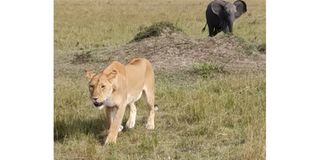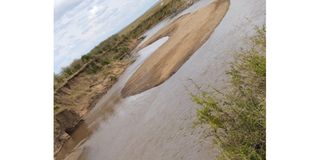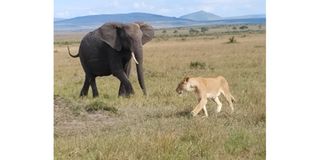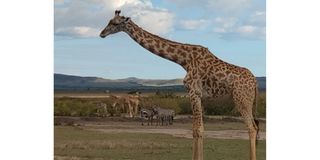The amazing wildlife of the Mara

1 Lioness moves away from elephant and misses her chance to hunt her warthog in Mara.. Photo | Rupi Mangat
What you need to know:
From hippos, lions, and gazelles to cheetahs and vultures, the Mara is a playground for everything wild
There’s always drama in the Mara. It’s the start of another year and the rain falls giving the land respite from the long hot months. A spectacular rainbow arches across the heavy grey sky and a flock of sand grouse drink their fill from the puddles. The male of this amazing chicken-sized bird soaks its feathers in water to carry to the chicks, which then suck on them. Nature is amazing.
A pride of lions dozes by the lugga unfazed by the cars. It’s a handsome black-manned lion with his consorts and cubs. We continue with the game drive through the plains where pops of brilliant red fireball lilies are in bloom. A few spotted hyenas lounge in the puddles of water by the Mara River which is at a low ebb with a fish-shaped sandbar exposed.

Fish-shaped sandbar on Mara River. Photo | Rupi Mangat
It’s chilly and the hippos seem to feel it too. A huge pod slumbers on the banks of the river and as the eye travels across the earthy waters, what look like logs, turn out to be crocodiles.
We enter animals seen on Makenya, the mammal app to help scientists map out the distribution of wildlife in real-time to aid in conservation strategies.
The Mara Cats
Camouflaged in the upper branches of a lone tree, is an impala. Its neck and legs dangle in the breeze. It can only mean one thing – the leopard is around.
And for sure, she’s sitting in the shrub, holding us spellbound and for a while, it’s only her and us. The following day, she’s still where we left her. This time she strolls halfway to the tree. The excitement builds up as we wait for her to climb the tree. But she changes her mind and walks back to the bush. We wait –maybe she will go up the tree to devour the impala. She stands, walks midway and changes her mind again.
It’s like she’s having a good time teasing the humans.
After a long wait, we have to concede that she may or may not go up the tree.
We follow a pair of cheetahs after the leopard. The Mara is a cheetah strong-hold. A long-term study of the Mara cheetahs by Dr Elena Chelysheva the founder of the Mara-Meru Cheetah project shows that at the last survey in 2021, 62 adults were recorded.
Once abundant in Kenya with a population of 100,000 at the start of the 20th century, the global population today of the spotted cat in the wild is down to 7,100.

Lioness moves away from the elephant as she was preparing for a hunt in the Mara. Photo | Rupi Mangat
“The highest number of adults observed in the Mara ecosystem since 2012 was in 2020,” she tells. “There were 72 adults.”
Unfortunately, cheetah numbers continue to decline in the Mara for a number of reasons, the chief amongst them – the space for them to live.
Our next heart-beating moment is the lioness who walks away from the male, across the dry granite lugga, and further into the horizon. We keep a respectable distance from her. She looks intent on a hunt and we see a family of warthogs. That’s her quarry.
She crouches. Waits. Takes a few more strides. Crouches again, completely camouflaged. The giraffes watch alert but the warthogs seem oblivious. It’s a kill in the making.
But it’s Murphy’s law. A herd of elephants appear, and the young male walks up to her. She has to move out of the way. Alone, she’s no match for him. It’s another day saved for the warthogs.
Fact File
We stayed at Mara Tipilikwani Camp on the banks of the Talek where every tented abode is named after a visionary figure from Kofi Annan to Jomo Kenyatta.
It’s a small camp with huge luxury canvas tents, which is a spacious en suite with private decks. It’s a 5-minute drive to the Talek gate into the Mara National Reserve.
The Mara has accommodation for all – from campers to budget; from comfortable to ultra-luxury.
Fly (45 minutes) from Wilson airport with Safarilink or Airkenya or enjoy a six-hour drive through the Great Rift Valley. Ensure you have a sturdy 4-wheel drive.
Be caring
Please carry binoculars so that you do not get too close to the animals, especially the cats. It disturbs them, sometimes even interrupting their hunt.

Maasai giraffe in the Mara - an endangered species today. Photo | Rupi Mangat
Picnic under the tree – please ensure it’s not with a vulture or eagle’s nest on it. Too much disturbance keeps the parents from feeding the chicks – which may cause them to starve.
The Mara is huge – 1,500 square kilometres. Two nights should be your minimum stay.
Be adventurous if you’re driving – to drive across the Mara, up the escarpment and further to Kisumu on Lake Victoria.
www.rupitheafricantrotter.com




